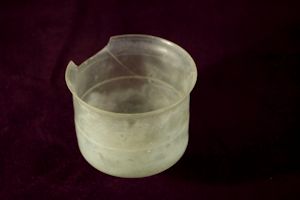
Cite this as: Compton, J., Price, J. and Worrell, S. 2015, The Roman Glass, in M. Atkinson and S.J. Preston Heybridge: A Late Iron Age and Roman Settlement, Excavations at Elms Farm 1993-5, Internet Archaeology 40. http://dx.doi.org/10.11141/ia.40.1.compton2
A total of 713 glass fragments, including ninety-six sherds of window glass, was recovered from 323 contexts. The assemblage covers the entire Roman period, with the peak of glass use occurring in the 2nd to mid-3rd centuries. The collection is one of the largest recovered from excavations in Essex, outside Colchester. Several vessels are represented by more than one sherd, and there are two almost-complete vessels, both recovered from cremation burials. The high proportion of diagnostic pieces demonstrates that a reasonably wide range of vessels was in use at Heybridge. In addition to the window and vessel glass, there are sixty-one beads and eight other objects, comprising one finger-ring, three counters, two hairpins and two opaque blue 'tesserae'.
Much of the glass was retrieved by hand, but the extensive environmental sampling programme resulted in a large proportion of the fragments, c. 180 (22%), deriving from bulk soil samples. Nineteen are beads, but nearly all the remainder consists of tiny chips of thin-walled vessel glass that provide little information other than to confirm the proportions obtained by macroscopic collection.
Initial cataloguing of the glass assemblage was carried out by Sally Worrell (see archive). The report was prepared by Joyce Compton, in collaboration with Sally Worrell and Dr Jennifer Price. Entries for the main items of vessel glass are presented in the catalogue sections below. The glass beads and other objects, and the window glass, have been incorporated into the Finds Function section (see FF1, FF5 and FF9/11) for wider distribution and function considerations. In addition, glass items with a funerary connotation can also be found in the religious and ritual section. The full glass report , with catalogue concordances, is held in the archive.
As might be expected, vessel glass dominates the assemblage, and a wide range of vessel types is represented, although numbers of individual types are small. Many of the forms commonly found on Roman sites are restricted here to just a few examples. Almost half of the total assemblage comprises vessels in natural blue-green glass. The vessel glass falls into three main groups; cast, mould-blown and blown, of which the blown vessels constitute the largest. This group has therefore been divided, as far as possible, into vessel types; cups/beakers, bowls, jugs, jars, flasks and bottles. Entries for each type are then ordered chronologically.
Few fragments from early cast vessels were recorded, with just eight examples identified. Forty-eight fragments and chips of monochrome glass in several strong colours were also noted. Strongly coloured glass is usually dated to the second half of the 1st century AD, although yellow-brown and yellow-green glass continued into the 2nd century. Vessels in four main colours occurred at Elms Farm; eighteen fragments are dark blue, thirteen are yellow-brown, six are yellow-green and nine are pale green. A range of vessels is represented, including cups, beakers, bowls and jars. The majority of fragments, however, are likely to be from jugs, the presence of which is attested by ribbed fragments and ribbon handles. Although quantities are small, strongly coloured glass is evenly distributed across the excavated area with half of the total occurring in Period 3 (early Roman) contexts.

Colourless glass for tableware began to replace that in strong colours during the later 1st century AD (Allen 1999, 117). Over one hundred fragments and chips were recovered in a variety of vessel forms, including cups and beakers, bowls and flasks. Of note is a near-complete cylindrical wheel-cut cup (Figure 420.14 and Figure 428) retrieved from cremation burial 12219. A peak in colourless glass vessel use, or at least in its disposal, occurred during Period 5 (late 3rd/mid-4th century), and fragments are not evenly distributed. The largest amounts occur in the northern settlement zone and the eastern part of the southern zone.
More than two hundred fragments of natural blue-green glass in a wide variety of forms were found, the largest category comprising containers, namely jugs, flasks and bottles. A near-complete, but fragmentary, flask (Figure 424 and Figure 429) was retrieved from cremation burial 12203. Blue-green glass fragments are fairly evenly distributed, although there is a slightly higher incidence in the central zone, and also in the eastern part of the southern zone. Few sherds came from the western part of the southern zone and very little glass of any sort came from the peripheral zone. Disposal of this vessel glass type occurs mainly during Period 3, and quantities remain low but steady thereafter until the mid-4th century.
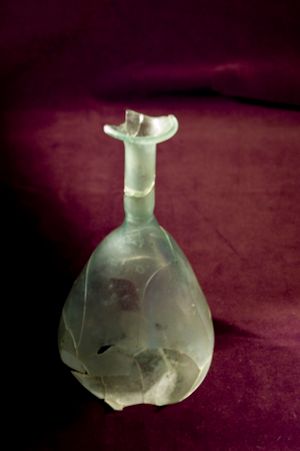
Glass vessels gradually changed in appearance during the second half of the 3rd century. The colour became more yellowy-green and the metal contained many impurities and bubbles. The forms that first appeared during the 3rd century and developed into 'cone beaker' types, can continue into the 5th century, although there is little evidence for these later vessels at Elms Farm. Deposition of Late Roman vessel forms began during Period 5 and declined sharply towards the mid-4th century. Fragments are fairly evenly distributed, with the largest amounts occurring in the eastern part of the southern settlement zone and, perhaps more significantly, in the vicinity of the temple in the central zone.
Fragments from two early Imperial, cast glass vessels were recovered, two from one yellow-brown ribbed bowl, and the third from another (Figure 419.1-2). The fragments are in a very abraded condition, consistent with recovery from the topsoil during machine-stripping. These vessels were manufactured in the late 1st century BC or the early years of the 1st century AD, and thus may have arrived in Britain before the conquest. Pre-conquest occurrences of glass on settlement sites are very infrequent (Price 1996, 53), and few find spots are known. These include Braughing where five early vessels were recorded (Price and Cool 1988, 79) and Camulodunum where only three such vessels were identified (Harden 1947, 288). None was recovered from the 1970 Sheepen excavations (Niblett 1985, 136). A ribbed bowl was found in the Welwyn-type burial at Hertford Heath (Hüssen 1983, 9, pl. 4), although this example is thick-walled with short thick ribs. The vessel was considered to be a ribbed version of the thick-rimmed shallow bowls which have a wide distribution in the eastern Mediterranean region, and, as such, was likely to have been produced before c. 70 BC (Price 1996, 52). An eastern Mediterranean origin for these early vessels has been proposed (Hüssen 1983, 9). Although the Elms Farm fragments are unstratified, there is no doubt that these are rare Augustan pieces and thus provide important evidence for the pre-conquest import of glass vessels to a British settlement site. Since the Elms Farm bowls are finer than the Hertford Heath example, an eastern Mediterranean origin is not certain. It is possible that they were imported from a source closer to Britain, such as Italy.
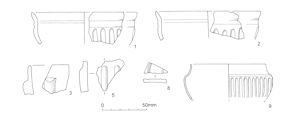
Other cast vessels are poorly represented. Six examples from pillar-moulded bowls are present, all in blue-green glass. There are also two small dark blue fragments from cast bowls or plates, one of which could be from a further pillar-moulded bowl. One blue-green base sherd (Figure 419.8) has interior wheel-cut lines, which normally indicates a vessel of good quality. The form is described in Price and Cottam (1998, 44-6). The pillar-moulded bowl was the most common type of tableware found at Colchester (Cool and Price 1995, 15) and is a frequent site find in mid-1st to early 2nd century AD contexts. Even small fragments of these vessels are distinctive and easily identifiable, so the small number recorded at Elms Farm is all the more remarkable. Large numbers were found both in the colonia and Camulodunum (Cool and Price 1995, table 1.2; Harden 1947, table p.288), and are common finds elsewhere in Essex, for instance, at Stansted, where a complete pillar-moulded bowl was found in a cremation burial (Price and Cottam 1998, 46, fig. 7, pl. 3.1). The range of Claudio-Neronian polychrome cast vessels found at Sheepen (Harden 1947, 289-92; Niblett 1985, 136, fig. 80) and Colchester (Cool and Price 1995, 17-18, fig. 2.2, 27-30, fig. 2.9) is conspicuously absent at Elms Farm.
1. Rim and upper body fragments, ribbed bowl. Yellow-brown. Slightly out-turned rim, convex body tapering in. Parts of five vertical ribs in low relief. Broad shallow ridge and groove ground at shoulder above ribs. Broad wheel-cut line below rim on interior. Rim, shoulder and inside surface ground. All surfaces heavily scratched and worn. Rim dia. 110mm, thickness 2-4.5mm. 17000, unstratified, Area A4
2. Rim and upper body fragment, ribbed bowl. Yellow-brown with green tinge. Slightly out-turned rim, convex body tapering in. Parts of five vertical ribs. Narrow groove ground at shoulder above ribs. Broad wheel-cut line below rim on interior. Rim, shoulder and inside surface ground. All surfaces heavily scratched and worn. Rim dia. c. 110mm, thickness 3-4.5mm. 17000, unstratified, Area A4
3. Rim and upper body fragment, pillar-moulded bowl. Pale green. Vertical rim. Part of one prominent vertical rib. Ground on inside surface and lightly at rim, ribbed area shiny. Tooling marks below rim. Edge of rib worn. Rim dia. c. 170mm, thickness 3-11mm. Cleaning layer 5601, Area I
4. (Not illustrated) Rim, shoulder and upper body fragment, pillar-moulded bowl. Pale green. Vertical rim. Trace of one vertical rib. Ground on inside and lightly at rim, shoulder and ribbed area shiny. Rim dia. c. 160mm, thickness 2.5-5mm. Layer 6418, Group 506, Area H, Period 3
5. Body fragment, pillar-moulded bowl. Blue-green. Slightly convex side. Bottom of shoulder, part of two vertical ribs with rounded tops. Ground on inside, ribbed area shiny. Edges of ribs very worn. Scratched internal surfaces. ?One edge grozed. Fill 11310, Pit 11304, Group 674, Area N, Period 4
6. (Not illustrated) Body fragment, pillar-moulded bowl. Blue-green. Convex side. Part of one vertical rib. Ground on inside, ribbed area shiny. Rib heavily chipped. Cleaning layer 5601, Area I
7. (Not illustrated) Lower body fragment, pillar-moulded bowl. Blue-green. Convex side. Part of one vertical tapering rib. Abraded band on inside surface near base. Ground on inside, ribbed area shiny. Some small bubbles. Strain crack. Fill 13820, Gully 13821, Group 3016, Area I, Period 3
8. Base fragment, pillar-moulded bowl. Blue-green. Flat base, curving up slightly. One small wheel-cut circle at centre of base and two wheel-cut lines at edge of base. Strain-cracked. Fill 17258, Ditch 17412, Area Q, Period 2B
Decorated mould-blown vessels were made in considerable numbers during the second half of the 1st century AD. These include circus and gladiator cups, along with cups and beakers with various schemes of vegetal or ribbed designs. None of the more decorative vessel types was found at Elms Farm, however, but fragments from two mould-blown ribbed bowls in blue-green glass were recorded (Price and Cottam 1998, 60-1, fig. 14; Cool and Price 1995, 51-3). These ribbed vessels are fairly common Claudian to early Flavian types in southern Britain (Price and Cottam 1998, 60). They are among the earliest mould-blown forms recognised and a date range of AD 50-75 has been assigned. The illustrated example was found in a mid- to late 1st century AD pit, but the second is unstratified.
9. Rim, shoulder and upper body fragment, hemispherical ribbed bowl. Blue-green. Vertical rim, edge cracked off and lightly smoothed, slightly concave shoulder, change of angle to convex body. Parts of eleven close-set vertical ribs in low relief on body. Many small bubbles. Edges of ribs lightly worn. Rim dia. 110mm, thickness 0.6-1.7mm. Fill 24077, Pit 24075, Group 900, Area M, Period 3 (Figure 419)
10. (Not illustrated) Body fragment, hemispherical ribbed bowl. Blue-green. Convex side. Parts of three, and trace of fourth, close-set, evenly spaced vertical ribs. Thick-walled. Small bubbles. 4000, unstratified, Area A1
This constitutes the largest group of vessels, of which those in blue-green glass form the largest component. In line with the lack of polychrome cast vessels, early polychrome blown glass forms are entirely absent. In contrast, pieces from twenty-four polychrome vessels were recorded at Colchester (Cool and Price 1995, 56), along with thirty-eight from previous excavations. Most of the blown forms from Elms Farm are relatively plain and any decoration is restricted to wheel-cut lines and applied self-coloured trails.
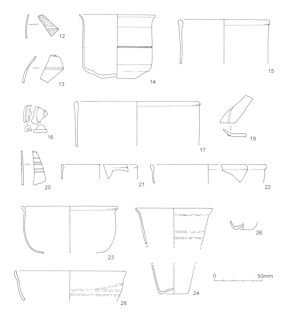
A range of cups and beakers was recorded. Numbers 11 and 12 are from Hofheim cups (Price and Cottam 1998, 72-3) which have a date range of AD 40-75. That only two were noted is worth mention, as over fifty were found in the recent excavations at Colchester (Cool and Price 1995, 64). Cylindrical colourless cups with wheel-cut or applied-trail decoration are slightly more numerous (Figure 420.13-19). Colourless glass tableware became more common during the 2nd century. Numbers 13 and 14 have cracked-off rims (Price and Cottam 1998, 88-9, 94-5). Number 14 is near-complete, recovered from cremation burial 12219, dated AD 125-45 by an almost-complete samian dish, confirming the date given in Price and Cottam (1998, 95). Numbers 15-19 are cups that have fire-rounded rims (Price and Cottam 1998, 99-101) and Nos 20-23 are similar cylindrical cups in blue-green glass. Number 20 has trailed decoration and may be from a 2nd-century cup, or beaker, such as that in Price and Cottam (1998, 103-4) although the Elms Farm example is indented. This is uncommon, and the vessel may be a later type. Cylindrical cups are the dominant drinking vessel class during the late 2nd and early 3rd centuries (Cool and Price 1995, 83) and a large number was recovered at Colchester. A minimum of four cups in blue-green glass were recorded at Elms Farm, which is a low figure when compared to the sizeable proportions recovered from elsewhere (see Cool and Price 1995, 83).
Late Roman cups and beakers are represented by Figure 420.24-28. These are made in the typical low-quality, bubbly and streaky glass that was in common use from the end of the 3rd century. The type of convex bowl represented by Figure 420.28 is widely found on 4th-century settlements (J. Price 2000, 6, fig. 3.1-2) and the Elms Farm vessel was found, appropriately, in a mid- to late 4th-century layer. A minimum of two conical beakers was recorded (Price and Cottam 1998, 121-3) and several convex bowls (Price and Cottam, 1998, 126-7). Late Roman vessels are fairly well represented in comparison with earlier vessel types, although forms with fire-rounded rims (Price and Cottam 1998, 129-31), dated to the later 4th/5th century, are absent.
11. (Not illustrated) Rim and upper body fragment, convex cup. Dark blue. Vertical rim, edge cracked off and ground, slightly convex side. Narrow abraded band below rim. Strain cracks. Rim dia. c. 65mm, thickness 1.8-2.5mm. Fill 4164, Pit 4163, Group 729, Area K, Period 3
12. Body fragment, convex cup. Blue-green. Convex side. ?Three broad bands of horizontal abrasion. Heavily scratched. Many small bubbles. Spread 5148, Group 457, Area J, Period 6
13. Upper body fragment, ?cup/flask. Colourless. Convex side, constriction above body, ?trace of rim or neck. Two broad, close-set horizontal wheel-cut lines. Strain cracks. Light iridescence. Fill 14093, Pit 14099, Group 4019, Area K, Period 4-5
14. Almost complete, cylindrical wheel-cut cup. Colourless. Small area missing from rim. Slightly out-turned rim, edge cracked off and ground smooth. Cylindrical body, tapering in slightly to small flat base that thickens towards the centre with a small central concavity. Faint horizontal abraded lines below rim, on upper body and above base, and two close-set, broad, wheel-cut lines around the centre of body. Edge of base lightly worn and scratched. Small to large bubbles. Strain cracks. Rim dia. 80mm, base dia. 35mm, height 61.5mm, thickness 1mm. Fill 12214, Cremation Burial 12219, Group 964, Area R, Period 3
15. Rim and body fragment, cylindrical cup. Colourless with greenish tinge. Slightly in-turned rim, edge fire-rounded. Straight side. Small bubbles. Light iridescence. Rim dia. 92mm, thickness 1.5-3mm. Fill 8990, Well 8989, Group 662, Area P, Period 4
16. Three base fragments, cylindrical cup. Colourless. Flat base with tubular base ring and thick trailed ring in centre. Light wear on base edge. Internal surface heavily scratched. Base dia. 55mm, thickness 1.5-8mm. Fill 9628, Ditch 25031, Group 834 Area D, Period 5
17. Nine body fragments, five joining in two groups, cylindrical cup. Colourless. Vertical rim, edge fire-rounded. Straight side. Light wear on interior of rim. Some very small bubbles. Rim dia. 156mm, thickness 0.8-3mm. 7000, unstratified, Area G
18. (Not illustrated) Two joining rim and upper body fragments, cylindrical cup. Colourless. Slightly in-turned rim, edge fire-rounded. Straight side. Light wear on interior of rim. Rim dia. 150mm, thickness 1.5-2.5mm. 7000, unstratified, Area G
19. Two lower body and base fragments, ?beaker/flask. Colourless. Convex lower body, slightly concave base. Curving colourless applied trail above edge of base. Base edge heavily worn. Many small bubbles. Base dia. c. 35mm, thickness 1.5-3.5mm. Layer 7596, Area G, Period 4
20. Body fragment, ?beaker. Blue-green. Straight side. Part of one indent and six irregularly spaced, narrow, horizontal or spiral trails. Strain cracks. Small bubbles. Cleaning layer 8000, Area E
21. Rim and upper body fragment, cylindrical cup. Blue-green. In-turned rim, edge fire-rounded. Slightly convex upper body. Green streaky impurity in rim. Many small bubbles. Rim dia. 80mm, thickness 0.8-1.8mm. Cleaning layer 6000, Area H
22. Rim and upper body fragment, cylindrical cup/small bowl. Blue-green. Funnel mouth, out-turned rim, edge fire-rounded. Dark yellow-green streaky impurity in rim. Rim dia. 112mm, thickness 1mm. Fill 10061, Pit 10062, Group 811, Area E, Period 4
23. Three rim, body and base fragments, two joining, small cylindrical cup/bowl. Blue-green. Slightly out-turned rim, edge fire-rounded. Straight upper body, curved change of angle, horizontal lower body. Trace of base ring. Small bubbles. Rim dia. 95mm, thickness 0.5-1.5mm. Fills 9324 and 9336, Ditch 9325, Group 776, Area D, Period 3C
24. Two fragments; rim and upper body fragment and lower body and base fragment, conical beaker. Pale yellow-green. Slightly out-turned rim, edge cracked off. Straight side tapering in to small concave base. Uneven band of horizontal abrasion below rim and two uneven bands on upper body. Many small bubbles. Rim dia. 80mm, thickness 0.5-1mm, base dia. 27mm, thickness 0.6-2mm. Layer 6008, Group 590, Area H, Period 5-6
25. (Not illustrated) Small rim fragment, beaker/bowl. Greenish-colourless. Slightly out-turned rim, edge cracked off. Narrow band of horizontal abrasion below rim. Fill 7100, Ditch 25040, Group 878, Area G, Period 5
26. Lower body and base fragment, conical beaker. Pale yellow-green. Straight-sided lower body tapering in to small concave base. Base edge worn. Bubbly. Base dia. 24mm, wall thickness 1mm. Layer 5453, Group 457, Area J, Period 6
27. (Not illustrated) Body fragment, ?cup/flask. Greenish-colourless. Convex side. Three narrow bands of faint horizontal abrasion. Very bubbly. Light iridescence. Strain cracks. Fill 4189, Oven 4005, Group 733, Area K, Period 4
28. Two joining rim and upper body fragments, convex bowl. Pale green. Out-turned rim, edge cracked off. Convex side, tapering in. Faint band of horizontal abrasion on upper body. Bubbly. Strain cracks. Rim dia. c. 120mm, thickness 2-2.5mm. Layer 6025, Group 573, Area H, Period 5
Deep tubular-rimmed bowls (Price and Cottam 1998, 78-80) are well represented, with at least ten vessels identified (Figure 421.31-7). Three are in strongly coloured monochrome glass, but most are blue-green. The type can have vertical or diagonal ribbing on the body, but the Elms Farm examples are all plain. This is a particularly common and widespread form with at least sixty vessels being recorded at Colchester (Cool and Price 1995, 94). Their usage extends from the mid-1st into the later 2nd centuries AD, but, as the Elms Farm examples are nearly all unstratified, no confirmation of the date is forthcoming. Bowls with out-turned rims, Figure 421.38-9 (Price and Cottam 1998, 106-7), are from vessels that are uncommon. Only six were identified at Colchester (Cool and Price 1995, 99). It is becoming clear that these bowls were in use during the 3rd century and the context evidence at Elms Farm tentatively bears this out. The base fragments (Figure 421.40-1) are probably from this type of bowl, and are included here for convenience. Late Roman forms are represented by Figure 421.45 and no. 46, not illustrated (Price and Cottam 1998, 124-5). These shallow hemispherical bowls with cracked-off rims are discussed in J. Price (2000, 12-14), and a bowl of similar form to the Elms Farm examples is illustrated (2000, fig. 5.3).
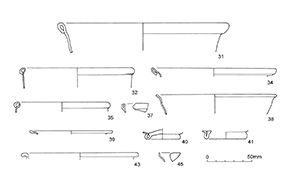
Deep tubular-rimmed bowls (Price and Cottam 1998, 78-80) are well represented, with at least ten vessels identified (Figure 421.31-7). Three are in strongly coloured monochrome glass, but most are blue-green. The type can have vertical or diagonal ribbing on the body, but the Elms Farm examples are all plain. This is a particularly common and widespread form with at least sixty vessels being recorded at Colchester (Cool and Price 1995, 94). Their usage extends from the mid-1st into the later 2nd centuries AD, but, as the Elms Farm examples are nearly all unstratified, no confirmation of the date is forthcoming. Bowls with out-turned rims, Figure 421.38-9 (Price and Cottam 1998, 106-7), are from vessels that are uncommon. Only six were identified at Colchester (Cool and Price 1995, 99). It is becoming clear that these bowls were in use during the 3rd century and the context evidence at Elms Farm tentatively bears this out. The base fragments (Figure 421.40-1) are probably from this type of bowl, and are included here for convenience. Late Roman forms are represented by Figure 421.45 and no. 46, not illustrated (Price and Cottam 1998, 124-5). These shallow hemispherical bowls with cracked-off rims are discussed in J. Price (2000, 12-14), and a bowl of similar form to the Elms Farm examples is illustrated (2000, fig. 5.3).
29. (Not illustrated) Body fragment, ?bowl. Dark blue. Slightly concave, vertical side, sloping in to carination. Surfaces lightly scratched. Cleaning layer 16051, Area H
30. (Not illustrated) Lower body fragment, ?bowl. Yellow-brown. Convex side, strong change of angle. Lightly scratched surfaces. Cleaning layer 9290, Area D
31. Three joining rim and upper body fragments, deep tubular-rimmed bowl. Blue-green. Slightly out-bent rim, edge bent out and down. Straight side. Rim dia. 185mm, wall thickness 1.5-2mm. Layer 9723, Group 1301, Area D, unphased
32. Rim and upper body fragment, tubular-rimmed bowl. Pale blue-green. Slightly in-turned rim, edge rolled in, then bent out and down. Straight side. Many small bubbles. Rim dia. 120mm, wall thickness 0.5mm. Fill 4030, Pit 4083, Group 739, Area K, Period 4
33. (Not illustrated) Rim and upper body fragment, tubular-rimmed bowl. Blue-green. Vertical rim, edge thickened, then bent out and down. Convex side. Rim dia. 140mm, thickness 1mm. Cleaning layer 15044, Area M
34. Rim and upper body fragment, tubular-rimmed bowl. Blue-green. Vertical rim, edge rolled in, then bent out and down. Straight side expanding out slightly. Rim dia. 160mm, wall thickness 0.6-0.8mm. Fill 8094, Well 8188, Group 788, Area E, Period 3
35. Rim and upper body fragment, tubular-rimmed bowl. Blue-green. Rim rolled in, then bent out and down. Rim dia. 110mm, wall thickness 0.7mm. Layer 6316, Group 547, Area H, Period 4
36. (Not illustrated) Rim and upper body fragment, tubular-rimmed bowl. Blue-green. Vertical rim, edge bent out and down. Straight side. Cleaning layer 20000, Area L
37. Rim and upper body fragment, tubular-rimmed bowl or jar. Blue-green. Vertical rim, thickened edge bent out then down. Straight-sided upper body tapering in. Layer 13348, Group 644, Area I, Period 5
38. Rim and upper body fragment, bowl. Blue-green. Out-turned rim, edge fire-rounded. Straight upper body tapering in. Rim dia. 140mm, thickness 1-1.5mm. Fill 9210, Ditch 9251, Group 776, Area D, Period 3
39. Rim and upper body fragment, plate/shallow bowl. Blue-green. Horizontal rim, edge fire-rounded, change of angle above body. Small bubbles. Rim dia. c. 100mm, thickness 1mm. Layer 10310, Group 1312, Area F, unphased
40. Lower body and complete base fragment, bowl. Blue-green. Wide horizontal lower body, tubular pushed-in base ring, concave base. Large central pontil scar. Slight wear on base edge. Base dia. 39mm, wall thickness 0.8mm. Layer 6227, Group 573, Area H, Period 5
41. Lower body and base fragment, bowl. Blue-green. Flat base, vertical pushed-in base ring. Base edge worn. Some large bubbles. Base dia. 48mm, thickness 1-2.5mm. Layer 6025, Group 573, Area H, Period 5
42. (Not illustrated) Lower body and base fragment, ?bowl. Blue-green. High vertical tubular base ring. Heavily distorted by heat. 12000, Unstratified, Area R
43. Rim fragment, bowl. Greenish-colourless. Out-turned horizontal rim, edge fire-rounded. Many small bubbles. Black specks. Strain cracks. Rim dia. 140mm, thickness 2mm. Fill 15056, Ditch 25079, Group 469, Area M, Period 5
44. (Not illustrated) Two joining body fragments, ?convex bowl. Colourless. Convex side. Narrow band of horizontal abrasion. Many small bubbles. Light iridescence. Layer 24243, Group 3044, Area M, Period 3
45. Rim and upper body fragment, convex bowl. Pale green. Curved rim, edge cracked off. Shallow, slightly convex body, tapering in. Several faint, horizontal, wheel-cut lines. Very bubbly. Rim dia. c. 110mm, thickness 1mm. 11000, unstratified, Area A2
46. (Not illustrated) Lower body fragment, cup/bowl. Greenish-colourless. Straight side, rounded change of angle. Broad band of faint horizontal abrasion above change of angle. Very bubbly. Thickness 1mm. Fill 5210, Pit 5209, Group 442, Area J, Period 6
A large number of jug fragments were recovered, most come from either conical or globular jugs. These types are described in Price and Cottam (1998, 150-2, 152-4, 155-7) and were almost certainly made in the north-west provinces. The main period of use covers the last third of the 1st century AD into the second half of the 2nd century. At least thirty vessels are in early strongly coloured glass, dark blue, yellow-brown and pale green; there is a significant amount of yellow-brown glass. Globular ribbed jugs in blue-green glass are 2nd-century pairings with tubular-rimmed bowls, such as nos 31-37, thus forming a set. Jugs are relatively common at Elms Farm and form the largest vessel group, after bottles, with at least forty vessels identified. Jugs were also common at Colchester (Cool and Price 1995, 123) and were a popular vessel type throughout Roman Britain.
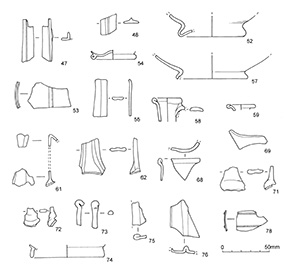
Spouted jugs (Price and Cottam 1998, 157-61) are poorly represented by comparison, as they are at Colchester (Cool and Price 1995, 131-4). At least four vessels were identified at Elms Farm (Figure 422.68-71). Figure 422.76 is a curiously folded piece, tentatively identified as a jug handle, although the fold appears to be on the internal surface. Unfortunately, insufficient remains of the sherd for certain identification. Late Roman vessels are represented by Figure 422.78 (Cool and Price 1995, fig. 8.11.1161). These jugs are discussed in J. Price (2000, 16).
47. Handle fragment, jug. Dark blue. Straight ribbon handle, one side missing. One very prominent central rib. Black impurities. Handle section 10x2mm. 13801, unstratified, Area J
48. Two fragments, handle and body, conical jug. Dark yellow-brown. Ribbon handle with pronounced central rib forming central prong. Straight side, part of shallow vertical rib. Layer 13468, Group 600, Area I, Period 3B
49. (Not illustrated) Two body fragments, conical jug. Yellow-brown. Straight side. At least one vertical rib. Surfaces lightly scratched. Some small bubbles. Fill 6203, Pit 6201, Group 530, Area H, Period 3
50. (Not illustrated) Base fragment, ?jar/jug. Dark yellow-brown. Edge of open base ring, concave base. Fill 4189, Oven 4005, Group 733, Area K, Period 4
51. (Not illustrated) Body fragment, ?conical jug. Pale green. Straight side, parts of three vertical ribs. Small elongated bubbles. Fill 14558, Pit 14529, Group 722, Area L, Period 6
52. Lower body and base fragment, convex jar or jug. Pale green. Wide convex side curving in to slight constriction above open pushed-in base ring and concave base. Base edge worn. Many small bubbles. Base dia. 65mm, thickness 2.5-4mm. 4000, unstratified, Area A1
53. Body fragment, convex jar/jug. Pale green. Convex side. One vertical rib. Many bubbles in streaks. Fill 9488, Ditch 25017, Group 150, Area D, Period 2B
54. Lower body and base fragment, jug. Pale green. Thin-walled convex lower body, tubular pushed-in base ring with concave base. Central pontil scar. Base edge lightly worn. Base dia. 50mm, thickness 0.2-3.5mm. 7000, unstratified, Area G
55. Handle fragment, jug. Pale green. Angular ribbon handle, central indent with rounded change of angle. Elongated bubbles. Red-brown inclusions. Cleaning layer 24058, Area M
56. (Not illustrated) Handle fragment, jug. Pale green. Plain rod handle with D-shaped section. Green streaky impurities. Heavily worn. Prepared surface 5786, Group 102, Area I, Period 2B
57. Two joining lower body and base fragments, jar/jug. Blue-green. Wide convex side curving in to slight constriction above open pushed-in base ring. Base edge lightly worn. Small to medium bubbles. Base dia. 60mm, thickness 2-3mm. Cleaning layer 5598, Area I
58. Rim, neck and handle fragment, jug. Pale blue-green. Out-turned rim, edge rolled in and flattened irregularly. Cylindrical neck. Handle applied below rim, pulled up and out. Return trail on rim edge. Yellow-green streak in rim. Many elongated bubbles. Rim dia. 31mm, int. neck dia. 13.5mm, thickness 2-3.5mm. Layer 10255, Group 840, Area F, Period 5
59. Rim and neck fragment, jug/flask. Pale blue-green. Horizontal rim, bent out, up and in irregularly and then flattened. Cylindrical neck. Bubbly. Rim dia. 30mm, thickness 2.5mm. Fill 10891, Pit 10910, Group 676, Area N, Period 5
60. (Not illustrated) Rim and neck fragment, jug. Blue-green. Horizontal rim, edge bent out, up, in and flattened. Cylindrical neck. Trace of handle on rim edge. Upper surface scratched. Rim dia. 32mm, int. neck dia. 16mm, thickness 1.3mm. Cleaning layer 10249, Area F
61. Four neck, handle and upper body fragments, two joining, convex jug. Blue-green. Cylindrical neck, expanding out to horizontal rim, edge missing. Angular handle with three ribs, pulled onto convex body. Elongated bubbles in neck and handle. Int. neck dia. c. 13mm, thickness 1.5mm. Layer 16236, Group 573, Area H, Period 5
62. Nine handle and body fragments, convex jug. Pale blue-green. Ribbon handle with three ribs, simple lower attachment. Convex side. Elongated bubbles. Fill 10182, Ditch 25245, Group 361, Area F, Period 3
63. (Not illustrated) Body fragment, conical jug. Blue-green. Straight side. Two narrow, slightly curving ribs and trace of a third. Strain cracks. Fill 13494, Hearth construction 18638, Group 625, Area I, Period 3
64. (Not illustrated) Shoulder fragment, jug. Blue-green. Curving shoulder, trace of neck. Four shallow curving ribs. Tooling marks on ribs. Strain cracks. Layer 13351, Group 626, Area I, Period 3
65. (Not illustrated) Handle and shoulder fragment, jug. Blue-green. Simple lower attachment of ribbon handle. Convex body. Elongated bubbles and black and yellow-brown streaks and specks in handle. Cleaning layer 6000, Area H
66. (Not illustrated) Handle and body fragment, jug. Blue-green. Thick ribbon handle with simple lower attachment. Straight side. Fill 14805, Pit 14806, group 707, Area L, Period 3
67. (Not illustrated) Handle fragment, jug/bottle. Blue-green. Upper section of plain angular ribbon handle. Black streaks and impurities. 7000, unstratified, Area G
68. Rim and upper body fragment, spouted jug. Blue-green. Funnel mouth, rim edge rolled in and flattened. One end pulled up to form spout (missing). Light iridescence. Fill 4925, Pit 4943, Group 739, Area K, Period 4
69. Rim fragment, spouted jug. Pale green. Funnel mouth, rim edge fire-rounded. Part of rim pulled up to form spout. Fill 8094, Well 8188, Group 788, Area E, Period 3
70. (Not illustrated) Rim and upper body fragment, ?spouted jug. Blue-green. Funnel mouth, rim edge fire-rounded. Streak of small horizontal bubbles below rim. Strain cracks. Cleaning layer 8261, Area E
71. Handle and shoulder fragment, jug. Blue-green. Ribbon handle, simple lower attachment. Convex shoulder. Irregular ridge on underside of handle. Fill 15043, Pit 15042, Group 650, Area M, Period 6
72. Handle and body fragment, jug. Blue-green. Oval-sectioned rod with simple lower attachment showing horizontal tooled impression. Two irregular ridges on underside of handle. Elongated bubbles in handle. Cleaning layer 6000, Area H
73. Handle fragment, jug. Pale blue-green. Upper section of oval-sectioned rod handle, small folded thumb-rest with tooled impression. Elongated bubbles. Fill 8187, Pit 8165, Group 790, Area E, Period 3
74. Lower body and base fragment, jug. Blue-green. Convex lower body tapering in. High, slightly diagonal, base ring. Base edge worn. Tooling marks on base ring. Many small bubbles. Base dia. 80mm, thickness 0.7-1.3mm. Fill 22024, Post-hole 22025, Group 5007, Area J, Period 5-6
75. Handle fragment, ?jug. Blue-green. Angular ribbon handle. Rib at edge formed by folding over edge. Trace of second rib. Yellow-green streaks. Heavily worn. Handle section, excluding rib, 14x3mm. 7000, unstratified, Area G
76. Handle fragment, ?jug. Blue-green. ?Straight, angular ribbon handle. Two vertical folded ribs. Handle section, excluding ribs, 26x2.5mm. Cleaning layer 5602, Area I
77. (Not illustrated) Body fragment, jug/jar. Blue-green. Convex side. Two unmarvered narrow horizontal trails. Very bubbly. Fill 9042, Pit 9007, Group 783, Area D, Period 3C
78. Body fragment, jug. Pale greenish-colourless. Convex side. Two horizontal unmarvered trails. Thin-walled. Very bubbly. Black specks and impurities. Fill 8141, Pit 8142, Group 836, Area E, Period 5
Few jars were recorded, and were recognised mainly by the form of the rim. Body and base sherds are identical to those from convex jugs and are usually identified as such. Numbers 79-82 represent collared convex jars (Price and Cottam 1998, 137-8), a very common form, and 83-85 are from convex jars with a horizontal rim (Price and Cottam 1998, 140-1). Convex jars were in use mainly during the 1st and 2nd centuries AD (Cool and Price 1995, 107, 109). Most of the examples from Elms Farm are unstratified, but the dating of the remainder does not conflict with the evidence from Colchester. Number 86 is from a jar with an out-turned rim (as Price and Cottam 1998, 143-5, fig. 62b; Price 1987, fig. 3.25). The vessel, from Felmongers, Harlow, is dated AD 160-70. The Elms Farm example is from a context dated mid-2nd to early 3rd century.
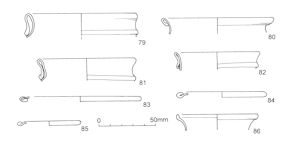
79. Rim and upper body fragment, jar. Yellow-green. Vertical rim, edge fire-rounded, then bent out and down. Upper body expanding out. Edge of rim lightly worn. Rim dia. 90mm, thickness 1.5mm. Fill 15543, Pit 15993, Group 691, Area M, Period 3
80. Rim and upper body fragment, jar. Pale green. Out-turned tubular rim, edge first fire-rounded, then bent out, down and in. Body expanding out. Many small bubbles. Black specks. Rim dia c. 110mm, thickness 1mm. Cleaning layer 6000, Area H
81. Rim fragment, jar. Blue-green. Slightly out-turned rim, edge rolled in, then bent out and down. Many small bubbles. Rim dia. 85mm, thickness 1.5mm. Fill 9008, Pit 9007, Group 783, Area D, Period 3C
82. Rim and upper body fragment, jar. Blue-green. Vertical rim, edge rolled in, then rolled out and down. Rim dia. c. 85mm, thickness 1mm. 7000, unstratified, Area G
83. Rim fragment, jar. Blue-green. Horizontal out-bent tubular rim, edge fire-rounded, then bent out, down and in. Lightly scratched. Rim dia. 112mm, thickness 0.8mm. Cleaning layer 8000, Area E
84. Rim fragment, jar. Blue-green. Horizontal out-bent rim, edge rolled up and in and flattened. Rim dia. 70mm, thickness 1.5mm. Cleaning layer 5723, Area J
85. Rim fragment, jar. Blue-green. Out-turned rim, edge rolled up and in, funnel mouth. Rim dia. 50mm, thickness 1mm. Fill 12080, Unknown cut 12371, Group 978, Area R, Period 4
86. Rim and neck fragment, jar. Blue-green. Vertical rim, edge fire-rounded and bent in, forming small 'step'. Funnel mouth, neck sloping in. Rim dia. 72mm, thickness 1mm. Fill 23025, Pit 23024, Group 906, Area N, Period 3
A small number of flasks are present, representing a range of forms. A complete blue-green flask (Figure 424.87) was recovered from cremation burial 12203, dated AD 120-150 by the presence of samian vessels. The form is similar to flasks found at Colchester (Cool and Price 1995, fig. 9.3.1172), and is comparable to Isings (1957) Form 28a. Conical flasks with funnel mouths are rare in burials; ovoid flasks, as represented by Figure 424.90 (Price and Cottam 1998, 171-2), are more common. Two examples of this type were retrieved from Cremation Group 4 at Sheepen (Niblett 1985, fig. 17), of Neronian date. The Elms Farm ovoid flask is from a late 1st-century context. Base fragments 90-93 can be paralleled with a 3rd-century base from Colchester (Cool and Price 1995, fig. 10.2.1575). The dating evidence from Elms Farm indicates an earlier date, perhaps first half of the 2nd century AD.
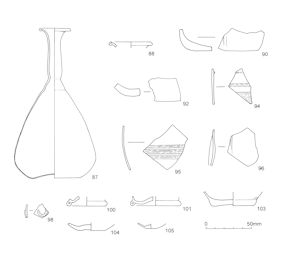
A body sherd (Figure 424.94) is an intriguing piece. This is probably from a flask, but there appears to be a horizontal rib on the interior surface. The vessel form is indeterminate, but the dating evidence suggests a late vessel (late 3rd/early 4th century). Further Late Roman forms are represented by Figure 424.95-6 (Price and Cottam 1998, 181-4), although the indented form of the flask (Figure 424.96) is uncommon. Fragments from a so-called Mercury flask were recorded (no. 97, not illustrated; Price and Cottam 1998, 179-81). These flasks are so named because they frequently carry moulded motifs underneath the base; sometimes these are representations of the deity. The Elms Farm example does not appear to have any moulding, but the piece comes from a mid-2nd century context, confirming the dating of the type. Finally, bath flasks have been identified only by their bases (Figure 424.103-5). These small globular-bodied vessels usually have a pair of opposing 'dolphin'-shaped handles (Price and Cottam 1998, 188-9). Many were found at Colchester (Cool and Price 1995, 156-9) and a base similar to those found at Elms Farm is illustrated (1995, fig. 9.9.1209).
87. Forty joining fragments, almost complete conical-bodied flask. Blue-green. Horizontal out-turned rim, edge partially rounded and rolled in. Funnel mouth. Long cylindrical neck. Straight side, tapering in to simple concave base. Very thin-walled. Many small bubbles, elongated in neck. Rim dia. 36mm, neck dia. 12mm, base dia. 52mm, wall thickness 0.2-1.5mm. Fill 12204, Cremation Burial 12203, Group 964, Area R, Period 3
88. Rim and neck fragment, flask. Blue-green. Rim out-bent almost horizontally, edge rounded and rolled in irregularly. Trace of cylindrical neck. Small bubbles. Black specks and inclusions. Rim dia. c. 50mm, thickness 1mm. Layer 6418, Group 506, Area H, Period 3
89. (Not illustrated) Shoulder and upper body fragment, ?flask. Blue-green. Convex body and curving shoulder with trace of neck. Two narrow bands of horizontal abrasion on upper body. Small bubbles. Collapse 7470, Group 873, Area G, Period 5
90. Lower body and base fragment, flask. Blue-green. Convex lower body, flat base. Many small bubbles. Base dia. c. 50mm, thickness 2-7.5mm. Fill 16213, Pit 16214, Group 571, Area H, Period 5
91. (Not illustrated) Lower body and base fragment, ?flask. Blue-green. Convex body tapering in to flat base. Scratched surfaces. Bubbly. Base dia. c. 75mm, thickness 2.5mm. Cleaning layer 5610, Area I
92. Lower body and base fragment, ?flask. Blue-green. Convex side curving in to convex base. Many small to medium bubbles. Heavily scratched. Fill 10283, Hearth construction 10798, Group 794, Area F, Period 3
93. (Not illustrated) Lower body fragment, ?flask. Blue-green. Convex side. Streak of small bubbles. Black inclusions. Heavily scratched. Layer 6340, Group 543, Area H, Period 4
94. Body fragment. Blue-green. Straight side. Two bands of horizontal abrasion and two further bands of horizontal abrasion running diagonally across. One horizontal rib on interior surface. Light iridescence. Lightly scratched. Fill 4994, Pit 4989, Group 1147, Area K, unphased
95. Two joining body fragments, flask. Greenish-colourless. Convex side. Five close-set broad bands of horizontal abrasion. Very bubbly. Lightly scratched. Layer 10315, Group 1313, Area F, unphased
96. Eleven neck, shoulder and body fragments, ?indented convex flask. Colourless with green tinge. Wide cylindrical neck, expanding out to missing rim. Curving shoulder, convex side, part of one deep oval indent. Seven close-set, narrow, horizontal abraded bands on body, and narrow abraded band on neck and shoulder. Many strain cracks on neck. Small bubbles. Iridescent surfaces. Neck dia. 40mm, thickness 1-1.5mm. Fill 10877, Pit 10910, Group 676, Area N, Period 5
97. (Not illustrated) Eleven body and base fragments, ?Mercury flask. Greenish-colourless. Part of one straight side, flat base. Thickness 5.5-7mm. Fill 9027, Pit 9014, Group 783, Area D, Period 3
A single fragment was identified; a colourless convex body sherd with an opaque blue trail. This type of decoration is known as 'snake-thread', where randomly applied patterns in relief are then grooved to produce a ridged appearance (Cool and Price 1995, 61). Snake-thread glass is not very common, usually found as single fragments on late 2nd and 3rd century sites (Cool and Price 1995, 62). This type of glass was manufactured in the north-west provinces, probably Cologne, and no complete vessels are known from Britain. Unfortunately, the Elms Farm example is unstratified.
98. Body fragment. Colourless with semi-opaque, mid-blue trails. Convex side. One curving 'snake-thread' trail with faint horizontal scored lines. Thickness 0.5-1.5mm. Cleaning layer 20000, Area L

Base fragments that are of uncertain form are described here (Figure 424);
99. (Not illustrated) Base fragment. Blue-green. Diagonal tubular, pushed-in base ring, concave base with kick in centre (missing). Trace of lower body. Junction of lower body and base grozed. Small pontil scar. Scratched surfaces. Base dia. 50mm, thickness 1.5mm. Layer 5494, Group 631, Area I, Period 3B
100. Base fragment. Blue-green. Slightly diagonal tubular base ring with concave base. Junction of lower body and base grozed. Base dia. 42mm, wall thickness 1mm. Cleaning layer 4881, Area K
101. Lower body and base fragment. Blue-green. Straight-sided lower body tapering in to tubular, pushed-in base ring with concave base and central kick. Strain cracks. Base dia. 55mm, wall thickness 1mm. Layer 13419, Group 634, Area I, Period 4
102. (Not illustrated) Lower body and base fragment. Blue-green. Wide convex lower body curving in to open, tubular, pushed-in base ring. Base edge lightly worn. Base dia. 60mm, thickness 2mm. Layer 10385, Group 8014, Area F, unphased
103. Lower body and base. Pale green. Convex side, flat thickened base, slight concavity in centre. Base edge heavily worn. Many small bubbles. Surfaces scratched. Layer 11368, Group 3081, Area N, Period 3
104. Lower body and base fragment. Pale blue-green. Convex lower body tapering in to flat thickened base with slight concavity in centre. Surfaces scratched. Base dia. c. 35mm, thickness 1.5-2mm. Fill 10361, Ditch 25027, Group 838, Area F, Period 5
105. Lower body and base fragment. Blue-green. Convex lower body curving in to small, flat, thickened base. Circular pontil scar. Thin-walled. Very bubbly. Base dia. 11mm, wall thickness 0.2-0.8mm. Fill 8991, Well 8989, Group 662, Area P, Period 4
106. (Not illustrated) Base fragment. Blue-green. Concave base with small central kick. Pontil scar. Surfaces lightly scratched. Light iridescence. Base dia. c. 50mm, thickness 3mm. Fill 14052, Pit 14098, Group 4019, Area K, Period 4-5
One hundred and sixty-five bottle fragments were found, representing about a third of the vessel total; seventy-nine are from prismatic bottles. These are containers used for bulk storage and transport, and are thus normally relatively thick-walled vessels with heavy bases. The outer surfaces are frequently badly scratched and worn, and vessels may have remained in use for a considerable time. Bottles can have either one or two handles. These are usually broad and angular, with ribbing or reeding. Many bases have moulded designs, which are sometimes attributable to the manufacturer, although much work on this aspect remains to be done. The main period of usage for bottles is thought to be during the 1st and 2nd centuries AD, although this is difficult to establish with accuracy (Cool and Price 1995, 184). Bottles are individually long-lived and break into large, thick fragments, which are prone to deposition, and redeposition, far removed from the initial point of use. Unfortunately, 40% of the bottle glass from Elms Farm was recovered from unphased contexts, and little can be deduced. Fragments of bottle glass were concentrated in the northern part of the central settlement zone. No bottle glass was found in the peripheral or hinterland areas of the site.
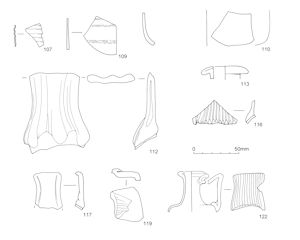
Two cylindrical bottles with a corrugated body (Frontinus bottles) were identified (Figure 425.107 and 108, not illustrated; Price and Cottam 1998, 209-11). These are relatively common, although the Elms Farm examples are almost miniature in size and, therefore, perhaps not so common. Two further fragments from a cylindrical bottle are from a two-handled version (Price and Cottam 1998, 204-7), and colourless cylindrical bottles are represented by nos 110-11 (Price and Cottam 1998, 202-4). The remaining bottles are all in blue-green glass and from square or prismatic bottles, except for Figure 425.112, the handle from a rectangular bottle (Price and Cottam 1998, 200-2). There is also a single body fragment from a hexagonal bottle (not illustrated; Price and Cottam 1998, 198-200).
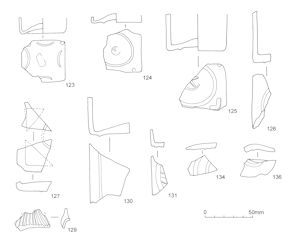
The square bottles all appear to be from small-bodied containers, many of which bear moulded designs on the underside of the base. The variation in base mouldings is diverse for such a small group of bottles. A range of designs is illustrated in Cool and Price (1995, figs 11.8-11.12). The most common design consists of concentric circles, sometimes with a central motif. The small size of the bottles indicates that only small quantities of the product they once contained were being transported into Heybridge.
107. Two body fragments, cylindrical bottle. Blue-green. Straight side. Parts of six close-set, irregular, horizontal mould-blown ribs. Very bubbly. Fill 12026, Ditch 12027, Group 968, Area R, Period 4-5
108. (Not illustrated) Body fragment, cylindrical bottle. Greenish-colourless. Straight side. Parts of two mould-blown horizontal ribs. Layer 23047, Group 3086, Area N, Period 3
109. Two body fragments, cylindrical bottle. Blue-green. Straight side. One broad band and two close-set, narrow bands of horizontal abrasion. Some very large bubbles. Light iridescence. Fill 4142, Pit 4141, Group 1147, Area K, unphased
110. Two joining ?body and base fragments, cylindrical bottle. Greenish-colourless. Straight side, curving base edge. Many strain cracks. Worn on base edge. Cleaning layer 5607, Area I
111. (Not illustrated) ?Shoulder and upper body fragment, cylindrical bottle. Greenish-colourless. Curving shoulder, straight side. Surfaces lightly scratched. Fill 9373, Ditch 9405, Group 776, Area D, Period 3C
112. Handle and shoulder fragment, rectangular bottle. Angular ribbon handle with three regular ribs pulled down onto shoulder, with rounded ends. Curving shoulder. Strain cracks. Many bubbles, elongated in handle. Fill 9895, Well 9421, Group 772, Area D, Period 3B
113. Rim and neck fragment, bottle. Slightly diagonal rim, edge bent out, up, in and flattened. Cylindrical neck. Surfaces scratched. Rim dia. 50mm, int. neck dia. c. 18mm, thickness 4-5.5mm. Cleaning layer 6000, Area H
114. (Not illustrated) Rim and neck fragment, bottle. Horizontal rim, edge bent out, up, in and flattened. Cylindrical neck. Rim edge lightly worn. Strain cracks. Rim dia. 52mm, thickness 5mm. 11000, unstratified, Area A2
115. (Not illustrated) Rim and neck fragment, bottle. Diagonal rim, edge missing. Cylindrical neck. Elongated bubbles in neck. Horizontal scratches on neck. Int. neck dia. c. 25mm, thickness 4-5mm. Fill 5162, Pit 5180, Group 443, Area J, Period 6
116. Handle and shoulder fragment, bottle. Angular ribbon handle, at least twelve ribs pulled down onto shoulder into prominent points. Curving shoulder. 7000, unstratified, Area G
117. Handle and shoulder fragment, bottle. Plain angular ribbon handle with simple lower attachment. Curving shoulder. Tooling mark on underside. Many elongated bubbles in handle. Surfaces worn. Red inclusions. Fill 10039, Pit 10038, Group 810, Area E, Period 4
118. (Not illustrated) Handle fragment, bottle. Upper section of angular ribbon handle with folded attachment and return trail. Tooling marks on underside. Elongated bubbles. 9000, unstratified, Area D
119. Handle fragment, bottle. Upper section of angular ribbon handle with simple folded attachment. Trace of cylindrical neck. Tooling marks on underside. Elongated bubbles. Strain cracks. All surfaces heavily worn. Fill 16230, Ditch 25260, Group 584, Area H, Period 6
120. (Not illustrated) Lower body and base fragment, cylindrical bottle. Slightly convex lower body tapering in to concave base. Edge of base heavily worn. Fill 11311, Pit 11304, Group 674, Area N, Period 4
121. (Not illustrated) Lower body and base fragment, ?cylindrical bottle. Convex lower body tapering in to concave base. Base edge lightly worn. Bubbly. Yellow-green impurity. 7000, Unstratified, Area G
122. Nine joining rim, neck, handle, shoulder and upper body fragments, small square bottle. Rim folded out, up, in and flattened unevenly. Cylindrical neck, expanding out slightly. Angular ribbon handle, folded upper attachment joined to neck and underside of rim, simple lower attachment with at least twelve shallow ribs combed onto shoulder. Trace of one straight side. Yellow-brown streaks in neck and rim. Elongated bubbles in neck and handle. Light wear on rim edge. Rim dia. 31.5mm, int. neck dia. 15mm, handle width 32.5-37.5mm, thickness 1.5-2.5mm. Layer 9510, Group 1301, Area D, unphased
123. Lower body and base fragment, small square bottle. Parts of three straight sides and trace of fourth. Concave base, raised design; four semi-circular mouldings in centre of each base edge in low relief, small circular pellets in two surviving corners and small circular pellet in centre. Pontil scar. Very bubbly. Base edge lightly worn. Fill 15869, Pit 15868, Group 698, Area M, Period 5
124. Two joining lower body and base fragments, small square bottle. Part of one straight side. Slightly concave base, raised design; faintly moulded circle, off-centre, within larger circle. Small circular pellet in one corner of base. Pontil scar in centre. Strain cracks. Many small bubbles. Internal surface lightly scratched. Spread 21514, Group 476, Area J, Period 6
125. Lower body and base fragment, small square bottle. Part of one straight side. Concave base, raised design; one circle with poorly-moulded 'X' at centre and two right-angled mouldings in the corners. Central pontil scar. Edge of mouldings lightly worn. Spread 20186, Group 8005, Area L, unphased
126. Lower body and base fragment, small square bottle. Parts of two straight sides. Flat base, raised design; part of one circle. Base pitted. Outside surfaces scratched. Base edge and moulding worn. Small bubbles. Cleaning layer 6000, Area H
127. Three lower body and base fragments, two joining, square/rectangular bottle. Parts of two straight sides. Flat base, raised design; parts of two triangular corner mouldings and small circle in centre. Base pitted. Pontil scar in centre. Edges of base worn. Strain cracks. Heavy iridescence. Small bubbles. Fill 4692, Slot 4695, Area K, unphased; Fills 4925, 4954, Pit 4943, Group 739, Area K, Period 4
128. (Not illustrated) Lower body and base fragment, square/rectangular bottle. Parts of two straight sides and edge of base. Heavily scratched. Very heavy iridescence. Fill 4081, Pit 4080, Group 62, Area K, Period 2A
129. Handle and upper body fragment, small prismatic bottle. Lower section of angular ribbon handle with eleven slightly curving ribs pulled onto shoulder. Trace of one straight side. Elongated bubbles in handle. 12000, unstratified, Area R
130. Lower body and base fragment, prismatic bottle. One straight side and trace of second. Flat base, shallow raised design; right-angled narrow bar parallel with the base edge. Base edge heavily worn and base heavily scratched. Many bubbles. Black streaky impurities. Layer 6238, Group 574, Area H, Period 5
131. Lower body and base fragment, prismatic bottle. Pale blue-green. One straight side. Flat base, raised design; part of circle close to base edge and further irregular moulding within circle. Indent in lower body. Very bubbly. Black and green streaks and impurities. Scratched surfaces. Layer 5907, Group 601, Area I, Period 3B
132. (Not illustrated) Lower body and base fragment, prismatic bottle. One straight side. Flat base, raised design; part of circle. Raised design heavily worn. Very bubbly. Fill 7458, Foundation pit 7461, Group 848, Area G, Period 3
133. (Not illustrated) Lower body and base fragment, prismatic bottle. Part of one straight side. Flat base, raised design; part of slightly curving feature running almost parallel to base edge. Base slightly pitted. 7000, unstratified, Area G
134. Base fragment, prismatic bottle. Flat base, raised design; two concentric circles surrounding central circular pellet and further circular pellet outside concentric circles. Strain cracks. Medium-sized bubbles. Edge of moulding lightly worn. Fill 7447, Gully 7454, Group 1349, Area G, unphased
135. (Not illustrated) Base fragment, prismatic bottle. Flat base, raised design; one circle. Base slightly pitted. Edge of moulding lightly worn. Cleaning layer 21500, Area J
136. Base fragment, bottle. Concave base, thickened towards centre. Circular raised moulding in centre and trace of further raised moulding. Many small bubbles. Lightly scratched. Layer 24243, Group 3044, Area M, Period 3
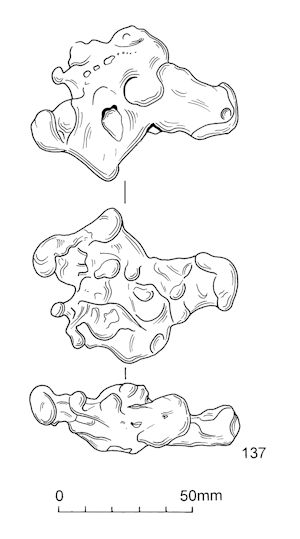
There are twelve blue-green heat-distorted fragments and four pale green examples, probably the melted remains of vessels. Six pieces came from a layer (24243) in the southern settlement zone, which also produced a large quantity of burnt pottery. A further large piece (Figure 427.137) was recovered from the fill of cremation burial 12219, from which a near-complete colourless glass cup (Figure 420.14) was also retrieved. Melted unguent flasks have been noted from other cremation burials (Price and Cottam 1998, 169), and the Elms Farm piece may also be the remains of a small flask. More specifically, it must have been a pyre offering.
137. Melted amorphous mass, blue-green. Precise form not identifiable, but possibly an unguent bottle. Fill 12214, Cremation Burial 12219, Group 964, Area R, Period 3
Little significance can be placed on so few pieces of melted glass, other than the remains of possible unguent bottle no. 137, although four of the remaining pieces are all from late Roman contexts. One of these contexts, pit fill 5162 in the temple area, produced a small rim fragment probably from a pillar-moulded bowl. Interestingly, the sherd is melted on the inside surface.
The presence of the two early ribbed bowls indicates that some glass was probably reaching Heybridge before the conquest. Exotic ceramic imports, such as Italian and Gaulish platters, and new products such as wine, were being imported into Heybridge from the mid-1st century BC. It is possible that the bowls accompanied these exotic commodities, although the import of glass vessels into Late Iron Age Britain is extremely rare. The few pieces of early cast glass noted at Camulodunum came from vessels of a different type. Ribbed bowls have previously been noted only in burials, perhaps indicating the highly prized nature of such imports. In contrast to Camulodunum, there appears to be a hiatus in glass importation to Heybridge in the mid-1st century AD. There are almost no vessels of Claudio-Neronian date, and certainly none in polychrome glass. This is in line with the pottery evidence, and might require explanation. Perhaps the conquest of AD 43 had little impact on the inhabitants of Heybridge. Contact with the continent had been well established by the late 1st century BC (see Atkinson and Preston 2015) and a sufficiently high degree of Romanisation might have already been achieved by the mid-1st century AD. Alternatively, as many polychrome vessels are Italian imports; the source of most of the glass for Heybridge could have been restricted to the production centres in Gaul.
Glass importation seems to have resumed during the later Neronian period, along with increased trade in samian tableware. The ordinary nature of the vessel glass assemblage is much in evidence. There appears to have been a steady use of vessels throughout the Roman period, but there is a paucity of forms. For instance, there is nothing that is highly decorated in the assemblage and there are no facetted or engraved cups. In addition, very little is in high-quality, colourless glass. Comparison with the tables showing glass forms in use at Colchester (Cool and Price 1995, 212-21) indicates that many of these forms are absent at Heybridge, and others are restricted to single examples. Even so, of the more utilitarian vessels, Heybridge has more than an adequate range, and there is some diversity of form. Very few high-quality pieces are present, but there are uncommon vessel types, such as the indented pieces (nos 20, 96).
Later Roman glass vessels, mainly beakers and bowls, are also fairly common. Those recovered all have cracked-off rims; later examples with fire-rounded rims are absent, although these beaker types were present in the Crescent Road excavations (Wickenden 1986, fig. 12.51-2). Fire-rounded rims are diagnostic of vessels of mid-4th to 5th century date (Price and Cottam 1998, 130) and their absence is interesting, although perhaps not totally unexpected, since the main focus of later activity seems to be to the north of Elms Farm. Later Roman vessels occur elsewhere in central Essex; at least eleven were recorded at Chelmsford (Drury 1988, fig. 75.13-5; Wickenden 1992, fig. 44.16-21) and both cracked-off and fire-rounded rims were identified. Beakers with fire-rounded rims were also recovered at Great Dunmow (Wickenden 1988, fig. 32.21-3; fig. 34.19-24) and Late Roman vessels were present at the villa site at Chignall St James (Clarke 1998, fig. 59.7-12).
Much of the assemblage consists of containers, with at least 60% of the vessel total comprising bottles and jugs. There is a very low proportion of cups (10%) and an equally low proportion of flasks. The use of glass cups and flasks as grave goods is well documented (Price and Cottam 1998), although certain types are more commonly found than others. The presence of glass vessels in graves at Heybridge perhaps indicates that cups and flasks were items of prestige, in view of their apparent scarcity. Glass use as pyre goods is also evident; melted glass unguent flasks are often found within cremation burials (Allen 1998, 27) and it is thought that the oils they contained were used to anoint the body during the funerary ritual. The empty flask may then have been placed on the pyre with the body, or perhaps at a later stage of the cremation process. Alternatively, a flask complete with contents may have constituted a pyre offering.
The significance of glass in ritual contexts is not usually considered, mainly because such a deposit is hard to recognise. Vessels that occur in burials are the obvious exceptions. Few other contexts with potentially ritual connotations, and that also contained glass, were recognised. Two examples in the vicinity of the temple have been tentatively identified, the first, pit 5180 (fill 5162), contained the rim fragment from a bowl. The interior surface of the vessel had been heated to melting point, for some unknown purpose. The second, pit 5209 (fill 5214), contained many small fragments of bubbly glass, all from the same vessel, with decoration in the form of abraded bands. The vessel form can be suggested, although there is no rim present, and is probably a Late Roman convex cup (Price and Cottam 1998, 117-19, fig. 48b). That the cup is in many small fragments may be due to the fragile, thin-walled nature of these vessels. However, the potential significance of numbers of very small fragments in a ritual connection has been noted at Fosse Lane, Shepton Mallet (Price and Cottam 2001, 170) and Uley (Price 1993, 210). Conclusions are difficult to reach with just two examples, but it is interesting that they are both open forms. Further research into ritual aspects of glass deposition may prove fruitful.
The presence of a high proportion of square and prismatic bottles probably indicates a relatively local source of production. Glass-making in Britain occurred in several places, the Colchester area among them (Cool and Price 1995, 209-10), although the evidence remains slight. It appears that the industry in Britain might have been restricted to the recycling of glass waste, and the subsequent production of containers. The lack of glass vessel remains, in comparison with those of pottery, has often been regarded as evidence for the collection and recycling of glass. This may well contribute to the apparent scarcity of glass vessels in many places, including sites in Essex. It has been noted above that Heybridge has produced the second largest glass assemblage after Colchester, but glass collections from elsewhere in Essex are poor. The site at Ivy Chimneys, Witham, with 240 vessel and 287 window fragments (Allen 1999, MF3.6), compares well with Heybridge but many others, including Chelmsford, have yielded less than a hundred fragments in total. Collection for recycling at every Roman settlement seems an unlikely premise to explain the scarcity of glass fragments. The most reasonable explanation is that glass supply itself was neither constant nor in any great quantity. This might be expected with a commodity which, in the main, is imported into Roman Britain. The major production centres in the north-west provinces are in the Cologne area, and perhaps trade links were only well established with large centres such as Colchester. Glass supply to settlements elsewhere may have depended on secondary supply from these major centres.
Internet Archaeology is an open access journal based in the Department of Archaeology, University of York. Except where otherwise noted, content from this work may be used under the terms of the Creative Commons Attribution 3.0 (CC BY) Unported licence, which permits unrestricted use, distribution, and reproduction in any medium, provided that attribution to the author(s), the title of the work, the Internet Archaeology journal and the relevant URL/DOI are given.
Terms and Conditions | Legal Statements | Privacy Policy | Cookies Policy | Citing Internet Archaeology
Internet Archaeology content is preserved for the long term with the Archaeology Data Service. Help sustain and support open access publication by donating to our Open Access Archaeology Fund.